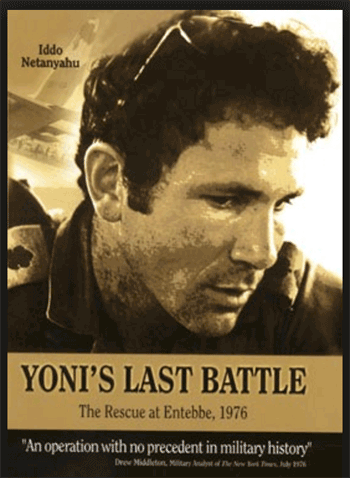
Christine Darg
By Christine Darg, Jerusalem Channel
Forty years ago the world was stunned by Israel’s daring raid to rescue Israeli and Jewish hostages held by terrorists at Entebbe airport in Uganda. It happened, amazingly, while the USA was celebrating the bicentennial of its July 4 Independence Day.
Then-President Gerald Ford made a proclamation:
“Our own Bicentennial Independence Day was enhanced by an event at Entebbe Airport in Uganda. That action of liberation freed our own hearts to fuller understanding of the universal meaning of independence – and the courageous action sometimes required to preserve it.”
I’ll never forget the privilege and honour of being an intercessor on that 4th of July 40 years ago. I’ll also never forget falling to my knees to implore God for a stunning miracle for Israel. Entebbe helped to teach me not to limit God in prayer! It seemed impossible that the hostages could be rescued so far from home and in such hostile conditions. But our God is a prayer-answering God!
Just a couple of weeks later, my husband and I participated in a press tour to Israel, and we interviewed the former hostages who were being assembled to give testimony for a famous movie made on the rescue mission.
Did you know that we often reap the benefits of our prayers for others?
About 20 years ago, we were airlifted out of Entebbe during a dangerous situation involving an open air Gospel meeting. The safest thing was for the Gospel team to leave the country quickly. As our light aircraft lifted off the runway, remains of the hijacked Air France jet that had been destroyed were still visible from “Operation Thunderbolt.”
I praised the Lord, the God of Israel, for remembering my prayers and for rescuing his people. We do reap what we sow!
But my personal miracle doesn’t end there. A couple of years ago, my humanitarian son and his wife were involved in a near crash mishap at Entebbe Airport, but their jet took off safely.
All praise and glory to the God of Israel who only does wondrous things!

Israeli 1977 4th of July cartoon
It was no accident that the Entebbe miracle happened on America’s bicentennial Independence Day. Israel’s and American’s destinies are intertwined. Hallelu-Yah!
Pray for Israeli Prime Minister Benjamin Netanyahu, who is scheduled to visit Uganda, Kenya and two other African countries to mark the anniversary. It will be an especially poignant visit for him, as the post below explains:

Jonathan Feldstein
By Jonathan Feldstein, Israel Correspondent
If you’ve never heard of Entebbe you’ve probably never heard of what makes Entebbe famous, or why that matters.
This July 4, as the US celebrates its 240th anniversary of independence, Israel and those who support her will celebrate the historic milestone and miracles connected to the rescue of hostages and heroic counter terrorism operation at Uganda’s capital, 40 years ago. The celebrated operation was comprised of tremendous bravery and numerous miracles.
On 27 June 1976, an Air France plane with 248 passengers was hijacked by Arab and German terrorists, and flown to Entebbe, Uganda’s main airport. Uganda’s government provided cover for the hijackers who were welcomed personally by dictator Idi Amin. In the ensuing week, as the United States was gearing up to celebrate its 200th anniversary of independence, Israel was gearing up for a brave, imaginative, and outrageously bold operation to rescue hostages held by the terrorists as yet another battle in a decades long fight to secure its independence.
While Israel had been fighting Arab terrorists for decades, the involvement of German terrorists brought back haunting memories of Jews being rounded up and murdered throughout Europe just 35 years earlier.
As horrific and scary as the situation was, throughout the planning and implementation of the rescue, it was clear how God’s protection of Israel against its enemies continued at every turn. Today, in a world where insidious Islamic terrorism flourishes, this remains a model of the resolve needed to overcome and defeat terrorists.
Initially, the terrorists separated the Israelis and Jews from the larger group of hostages and forced them into another room. The first day, 47 non-Israeli hostages were released. The next day, 101 more non-Israeli hostages were allowed to leave. More than 100 Israeli and Jewish passengers remained as the hijackers threatened to kill them if their demands were not met. This threat led to the planning of the rescue operation.
During the time between the hijacking and the rescue, Israel’s Mossad built an accurate picture of the hostages’ location, the number of hijackers, and the involvement of Ugandan troops from the released hostages. Additionally, because Israelis were involved in many building projects in Africa during the 1960s and 1970s, a large Israeli construction company had built the terminal where the hostages were held. This allowed Israel to construct a replica of the building with the assistance of those who had helped build the original, while planning the military operation. Divine intervention continued.
The Israeli government and military considered many options, yet what seemed like the most improbable choice was made. In a modern version of David– the child taking on Goliath the giant– an Israeli commando force of some 100 soldiers was trained and briefed, practicing and preparing for any imaginable scenario. One of these was securing a Mercedes, the same model belong to Idi Amin, painting it to look like Amin’s car and, after touchdown, driving that car loaded with Israeli troops straight to the terminal building.

Entebbe Hero Jonathan, brother of Prime Minister Benjamin Netanyahu
Operation Thunderbolt was led by Lt. Col. Yonatan Netanyahu, composed entirely of elite commandos. His unit was given the primary task of attacking the airport terminal and rescuing the hostages. A Paratroopers force was tasked with securing the civilian airfield, clearing and securing the runways, and protecting and fueling the Israeli planes. A group from Israel’s famed Golani unit secured the C-130 Hercules aircraft for the hostages’ evacuation, getting as close as possible to the terminal to board the hostages. Another elite commando unit was tasked with destroying the squadron of MiG fighter planes on the ground to prevent any possible interceptions by the Ugandan Air Force, and holding off potential hostile ground forces.
The operation took place under cover of night and a nearly new moon. In what took most of a week to plan, the operation lasted less time than the length of the movies made to tell the story. 102 hostages were rescued. Five Israeli commandos were wounded and one was killed. Three hostages, all the hijackers, and 45 Ugandan soldiers were killed. Most of Uganda’s Soviet-built MiGs were destroyed.
It would have been impossible for Israel to transport a convoy of planes and equipment 2500 miles alone, undetected, without God’s protection and the involvement of numerous people He set in place to help carry out the mission. Because of good relations in Kenya with the Jewish owner of the Block Hotel chain, and with other members of the Jewish and Israeli community in Nairobi, they used their influence to persuade Kenya’s President Jomo Kenyatta to help. Israel received Kenyatta’s permission for the IDF task force to cross Kenyan airspace and refuel at Nairobi’s International Airport. After the operation when it became public, it also became clear that Kenya’s President, a Christian, understood God’s imperative to bless Israel. His support provided cover and allowed the essential refueling of the Israeli planes. This was another way of God showing His Hand and merciful protection. Yet, in the aftermath of the operation, Idi Amin retaliated and slaughtered several hundred Kenyans in Uganda.

Jonathan Feldstein took this photo of the replica of Idi Amin’s Mercedes used in the raid. The car is on display in Tel Aviv.
Lt. Col. Netanyahu, the older brother of Prime Minister Benjamin Netanyahu, was the only Israeli military casualty of the entire operation. Operation Thunderbolt was renamed Operation Yonatan in memory of the unit’s leader, Yonatan Netanyahu.
I remember Operation Yonatan as if it were yesterday. The heroism and success was celebrated globally. It represented a combination of human bravery, imagination, the will to fight and overcome terrorists, and many instances of God’s protection. There are numerous examples of this all, and I welcome you writing to me and I’ll be glad to share other sources with you.
Indeed, with the rise of Islamic terrorists threatening Jews and Christians, and western civilization and the rest of the world, there are many inspiring lessons that can and should be learned from this to help in our fight against a new generation of the same terrorists.
Jonathan Feldstein was born and educated in the U.S. and immigrated to Israel in 2004. He is married and the father of six. Throughout his life and career, he has been blessed by the calling to fellowship with Christian supporters of Israel and shares experiences of living as an Orthodox Jew in Israel. He writes regular columns from Israel and can be reached at [email protected].
FAIR USE NOTICE: This website may contain copyrighted images. Such material is made available for educational purposes only. This constitutes a ‘fair use’ of any such copyrighted material as provided for in Title 17 U.S.C. section 107 of the US Copyright Law.












Great show of “love your Neighbor as your self even to the point of sacrificing
one’s life.
God bless and prosper all participants and their generation.